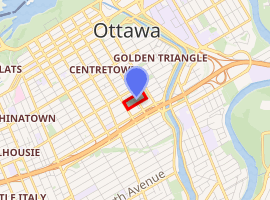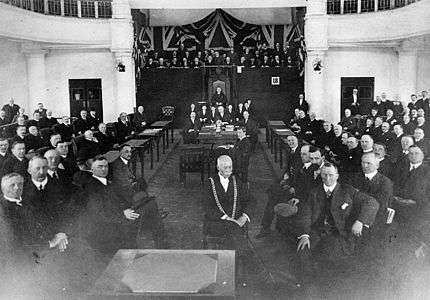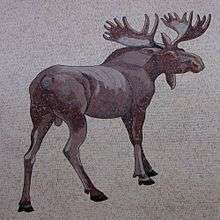Canadian Museum of Nature
The Canadian Museum of Nature (French: Musée canadien de la nature), formerly called the National Museum of Natural Sciences[1] (French: Musée national des sciences naturelles), is Canada's national natural history and natural sciences museum in Ottawa, Ontario. Its four main collections, which were started by the Geological Survey of Canada in 1856 and now include ca. 14.6 million specimens, are Botany, Mineralogy, Palaeontology and Zoology.
| Canadian Museum of Nature | |
|---|---|
Victoria Memorial Museum Building | |
The Victoria Memorial Museum Building | |

| |
| General information | |
| Type | Natural history museum |
| Architectural style | Gothic Revival, Scottish baronial |
| Location | Ottawa, Ontario, Canada |
| Coordinates | 45.41266°N 75.68875°W |
| Current tenants | Canadian Museum of Nature |
| Construction started | 1905 |
| Completed | 1912 |
| Owner | Government of Canada |
| Design and construction | |
| Architect | David Ewart |
| Official name | Victoria Memorial Museum Building |
| Designated | 1990 |
The museum is affiliated with the Canadian Museums Association, the Canadian Heritage Information Network, the Alliance of Arctic Natural History Museums, the Alliance of Natural History Museums of Canada and the Virtual Museum of Canada.
Exhibits
The exhibits and main programmes are housed in the Victoria Memorial Museum Building in Ottawa, at the museums public engagement campus.
The museum has eight permanent galleries:
- Fossil Gallery - skeletons and dioramas about dinosaurs and marine reptiles, and the events that led to their extinction and the rise of mammals approximately 85 to 35 million years ago. Nearly 85% of the specimens displayed in the gallery are genuine fossils (rather than fabrications or casts). The Canadian Museum of Nature is one of only a handful of museums in North America to display mostly original fossil material.[2]
- Earth Gallery - minerals and rocks, and how geological forces have shaped our planet.
- Mammal Gallery - Canada's wild animals, including mounts of grizzly bears, polar bears, bison, moose, caribou, pronghorns and cougars.
- Water Gallery - a blue whale skeleton, exhibits about life found in marine and fresh water environments and the critical role that water plays in sustaining all living things.
- Bird Gallery - nearly 500 mounts of 450 species of Canadian birds, multimedia experiences and interactive displays.[3] Several diorama backgrounds were painted by James Perry Wilson.[4]
- Nature Live - live insects, arachnids and slugs.
- Stone Wall Gallery - changing displays of art and photography about natural science.
- Landscapes of Canada Gardens - an outdoor botanical exhibit with zones representing three different ecosystems of Canada: Arctic tundra, boreal forest and prairie grasslands.
- The Canada Goose Arctic Gallery—a permanent gallery—opened in June, 2017. Contains specimens from the Arctic through authentic specimens and artifacts, stunning multimedia, indigenous perspectives, fun interactive games, guided learning, activities and more.
Features Arctic geography, ecosystems and sustainability, as well as the impacts of climate change. The National Film Board of Canada collaborated with the Museum that harnesses the power of real ice to create a window into the Arctic.
Research and collections
Collections-based scientific research has been a core component of the museum since its inception. Today, research at the museum is focused in two cross-disciplinary centres of expertise: the Centre for Species Discovery and Change and the Centre for Arctic Knowledge and Exploration.
Each of the museum's four main collections have several subcollections:
- Botany (Algae, Bryophytes, Lichens and Allied Fungi, Vascular Plants)
- Geological Collections (Minerals, Rocks, Gems, Mineral Occurrences)
- Palaeontology (Vertebrates, Plants, Fungi, Pollen)
- Zoology (Invertebrates: Annelids, Molluscs, Crustaceans, Insects, Parasites, Faunal Assemblage; Vertebrates: Fish, Amphibians and Reptiles, Birds, Mammals)
From 1972-2005 the museum published the scientific journal Syllogeus [url=https://www.biodiversitylibrary.org/bibliography/51992#/summary].
Natural Heritage Campus
The Natural Heritage Campus in Gatineau, Quebec, opened in 1997. It is the 76 hectare site of the museum's administrative operations and its extensive research and collections facility.[5] The campus is not open to the public except for an annual Open House that showcases its 14.6 million specimens, its research labs and its fossil preparation facility. The library, however, does allow visitors.[6]
History
The Canadian Museum of Nature has its origins in the Geological Survey of Canada, which was formed in 1842. Nearly 150 years later, on July 1, 1990, the museum became a Crown Corporation by an Act of Parliament.
The Museums Act was a significant event in the history of the museum. With Crown Corporation status came a new name, a new "arms-length" status and an expanded mandate: "The purpose of the Canadian Museum of Nature is to increase throughout Canada and internationally, interest in, knowledge of and appreciation and respect for the natural world by establishing, maintaining and developing for research and posterity a collection of natural history objects, with special but not exclusive reference to Canada, and by demonstrating the natural world, the knowledge derived from it and the understanding it represents." [7]
.jpg) Victoria Memorial Museum Building, Ottawa, 1911
Victoria Memorial Museum Building, Ottawa, 1911.jpg) National Museum of Canada library, 1912
National Museum of Canada library, 1912.jpg) Students in temporary exhibition of minerals, Victoria Memorial Museum Building, 1912
Students in temporary exhibition of minerals, Victoria Memorial Museum Building, 1912 Opening session of the House of Commons at the Victoria Memorial Museum after the Parliament Buildings fire of 1916
Opening session of the House of Commons at the Victoria Memorial Museum after the Parliament Buildings fire of 1916
The building

The building, known as the Victoria Memorial Museum Building and often referred to as the "castle", was built in former farm fields known as Appin Place, the estate of the Scottish-born merchant William Stewart. The neighbourhood became known as Stewarton and residential development started in the area during the 1870s.[8] The government purchased the land in 1905 hoping to develop the site as a sort of 'end piece' to complement the stone structure of the Canadian Parliament Buildings at the opposite end of Metcalfe Street, on Parliament Hill.[9]
This massive stone structure is an excellent example of early 20th-century architecture in Ottawa, and was built for $1,250,000 by architect David Ewart who is responsible for many similar structures around the city.[9] The construction of the building involved the importing of 300 skilled stonemasons from Scotland.[9] The architectural style is sometimes described as Scottish baronial. Ewart was sent to Britain to study the architecture of Hampton Court and Windsor Castle, which greatly influenced his design of this building.[10]
Because of the presence of unstable Leda clay in the geology of the site, a tall tower that was situated at the front of the building had to be taken down in 1915 due to settling and the concern that the foundation could not support the weight. The unstable site forced some workers to stop working, as shifting foundations in the basement shot bricks and stones out from the walls, hitting some construction workers.
The building found itself filling a more auspicious role than originally intended when in 1916, fire consumed the majority of the Centre Block on Parliament Hill. The then-recently completed Victoria Museum Building became the temporary home of the House of Commons from 1916 to 1919 and the affairs of the government were run from the site until the completion of the new Parliament building in 1922.[9][11] The Senate used the first floor mineral room (now the Fossil Gallery) and the Commons used the amphitheater on the third floor (now the Salon), which forced the Ottawa Little Theatre (then known as the Ottawa Drama League) to stop performing there.[12] Chairs and tables for members were brought in, as well as the speaker's chair for both the Senate and Commons. When former Prime Minister Sir Wilfrid Laurier died in 1919, his body was lain in state in the museum auditorium.
In 1956,[1] the National Museum that occupied the building was split into the National Museum of Natural Sciences and the National Museum of Man (renamed the Canadian Museum of Civilization, and later the Canadian Museum of History), although both entities continued to share the same edifice. In 1989, the then Canadian Museum of Civilization moved to a new location in Gatineau, Quebec, and the National Museum of Natural Sciences occupied the entire Victoria Memorial Museum Building.
In 1990, the National Museum of Natural Sciences was renamed with its current name, the Canadian Museum of Nature.[1] That same year, the Victoria Memorial Museum building was designated a National Historic Site of Canada.[13]
A major renovation of all parts of the building, including the exhibits, began in 2004 and was completed in 2010, including a glass "lantern" taking the place of the original tower that was removed in 1915. The weight of the lantern is cantilevered off the new elevator shafts; the building itself does not support it. For most of the duration of the renovation, parts of the building remained open to the public, but the entire building was closed temporarily on 26 April 2010 for final changes. The newly renovated museum re-opened on 22 May 2010, and the lantern structure was christened the "Queens' Lantern" in honour of both Elizabeth II, who visited the building on her 2010 royal tour of Canada, and Queen Victoria.[14][15][16]
National Herbarium of Canada
The National Herbarium of Canada[18] is housed within the Canadian Museum of Nature. The plant collections of the Geological and Natural History Survey of Canada were officially incorporated into the museum in 1882.[18] There are several distinct collections (numbers valid as of 2016):
- Vascular plant collection with ca. 650 000 specimens, including about 2500 type specimens.[18]
- Lichen and Allied Fungi collection with ca. 137 000 specimens, including about 750 type specimens.[18]
- Bryophyte collection contains ca. 268 000 specimens, and 950 type specimens.[18]
- Algae collection contains 3 016 440 specimens and 300 type specimens. It is kept in the National Phycology Collection of Canada.[18]
- Macroalgae collection contains 26 640 specimens. It is kept in the National Phycology Collection of Canada.[18]
See also
References
- Canadian Museum of Nature - Historical timeline, official website.
- Mallon, Jordan (2013-01-23). "Discussing Dinos at the Canadian Museum of Nature". Canadian Museum of Nature - Blog. Retrieved 2020-01-22.
- "Our exhibitions - Bird Gallery". Canadian Museum of Nature. Retrieved January 24, 2019.
- MacClintock, Dorcas,"James Perry Wilson and the Art of Background Painting," Discovery Magazine, Vol 12 No. 1, 1976
- "Our Research and Collections Facility". Canadian Museum of Nature. Retrieved 3 December 2014.
- "Library and Archives". Canadian Museum of Nature. Retrieved 3 December 2014.
- from the Museums Act, Chapter M-13.4 (1990, c. 3)
- Kalmam, 52.
- Fletcher, 148.
- Kalman, 52.
- "Parks Canada - Meetings of Parliament". Pc.gc.ca. 2005-02-22. Retrieved 2011-02-26.
- "History - Ottawa Little Theatre". Ottawa Little Theatre. Retrieved 2018-10-25.
- Victoria Memorial Museum. Canadian Register of Historic Places. Retrieved 7 March 2018.
- Canadian Museum of Nature - Grand Reopening Archived April 11, 2010, at the Wayback Machine
- Cook, Maria (2010-05-16). "Ottawa Citizen - The Wonders of Nature". Ottawacitizen.com. Retrieved 2011-02-26.
- Canada. "Her Majesty Queen Elizabeth II Marks the Naming of the "Queens' Lantern" at the Canadian Museum of Nature". Nature.ca. Archived from the original on 2012-07-30. Retrieved 2011-02-26.
- Extreme Make-over for Ottawa's Nature Museum Archived 2015-07-05 at the Wayback Machine, Canadian Geographic
- National Herbarium of Canada
Further reading
- Ray, Randy (27 April 2009), The Big Book of Canadian Trivia, Dundurn Press, ISBN 978-1-55488-417-9
